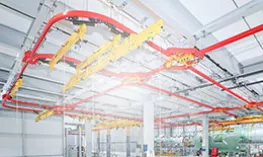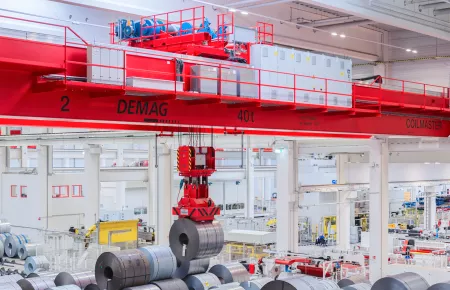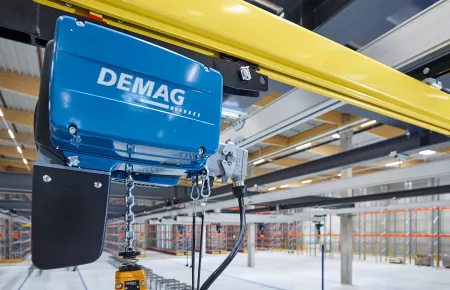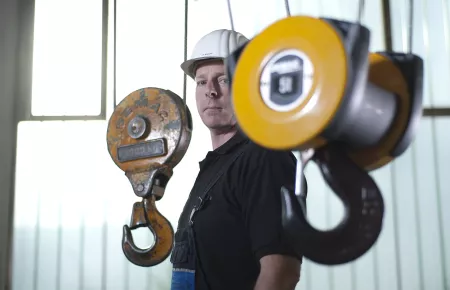Makeover for two overhead travelling cranes
- Demag Service modernises cranes in a hydroelectric power stationInvesting in cranes for the future
- Investing in cranes for the future
- Demanding construction site logistics
With a comprehensive modernisation package, Demag Service has given two identical double-girder travelling cranes a makeover at the Albbruck-Dogern (RADAG) hydrolec-tric power station. Following extensive work on the drive and control systems, both of the overhead travelling cranes, which are now more than 80 years old, meet state-of-the-art requirements and ensure high availability to support the replacement of machine parts.
Modernisation concept with demanding requirements
The two double-girder overhead travelling cranes were each equipped with a 150 t hoist unit and a cantilever crab to be able to perform repair work on the turbines and to replace machine parts. Besides the modernisation of the drive systems for three motion axes, the customer also wanted the entire electric equipment on the cranes to be replaced and a crane control system with safety functions to be installed. The availability of one crane installation had to be ensured throughout the entire conversion phase.
In order to lift the components, which weigh more than a ton, to the working level, Demag Service first installed a I-beam girder with a chain hoist below the building’s roof structure. This additional lifting device was the key for the logistics challenges at this construction site.
Carolin Paulus, Vice President Service and globally responsible for Demag Service, explains: “The demanding challenges of this project already became obvious during the planning phase. Besides a strong technical solution, the customer also needed an experienced team that not only covers the various disciplines required for crane and hoist applications, but also delivers performance and ensures reliable installation and smooth logistics on site.”
Two double-girder overhead travelling cranes which each have a load capacity of 150 t and travel on a runway in the machine shop at the Albbruck-Dogern power station (RADAG) have been completely modernised by Demag Service.
Lifting solution for 150 tons
The first requirement involved the replacement of the drive units on both of the 150 t hoist units, which had an additional intermediate gearbox. On the basis of a fresh survey, Demag Service designed a shaft with which the output of the new hoist motor is transferred to the gearbox. The integration of a safe dual-channel load sensor system in the steel superstructure of the existing crabs ensured that further requirements were met for the new lifting solution.
Improved flexibility with additional hoist units
Due to the limited capacities of the crab, the Demag modernisation experts developed a stand-alone tender solution which is mechanically coupled with the main crab for a second hoist unit. Thanks to its faster lifting speeds and smaller bottom block, the customer uses this 10 t hoist as a co-axial unit for flexible maintenance and repair work.
Previously, an additional hoist unit had travelled along the outer edge of the crane girder on a cantilever crab. This arrangement offers the advantage of also reaching the edges of the workshop with the crane hook. The installation of a new cantilever crab of compact design with a Demag 6.3 t rope hoist met the need for a versatile lifting device.
Drive concept with frequency inverter
The installation of a railing on the inside of the crane bridge as additional protection against falling provides for improved safety. All work on the walkways had to utilise bolted connections, since the riveted steelwork precluded any welding due to the expected deformation caused by the higher temperatures.
The previous complicated power supply line via a cable drum with a power infeed point in the centre of the workshop was replaced by a narrow conductor line system installed beneath the crane runway. The crabs are now supplied via trailing cable lines that are suspended from KBK 25 profile sections.
Makeover with state-of-the-art control system
The integration of many electronic components has enabled both overhead travelling cranes to bridge a technological gap of more eight decades and their control systems are now on par with those of current process cranes. To this end, a Siemens S7 failsafe PLC was installed which communicates via Profibus and Profinet.
The hoist unit and supporting structure are protected against overloads by the electronic load detector. The load spectrum recorder records all loads on the hoist units during operation.
Thanks to the new control system, synchronised operation of both cranes is ensured in tandem mode for the main lifting and cross-travel motions. In addition, run-on of the cross-travel drives has been synchronised. This enables the cranes to safely lift and transport the turbines and other large-volume parts of the installation, for example. To do this, both cranes communicate over a reliable Profinet connection via an optical data transfer system.
The inverter systems integrated into the installation also features power recovery, with which any superfluous energy can be utilised.
The cranes can be controlled at a convenient distance from the load via a radio control system that was also included in the modernisation package. The crane operator can also receive important status information and messages via the display on the radio transmitter.
Following the modernisation work, the crane still has some open gear components, which have to be reliably maintained. In the past, this had to be done regularly by hand. Today, the task is performed by a central lubrication system, which pumps the required lubricants to the various points where they are needed at specified intervals.
Hydroelectric power station for eco-friendly power generation
The Rheinkraftwerk Albbruck-Dogern hydroelectric power station (RADAG) was built between 1930 and 1933 on the border between Germany and Switzerland. As a running-water power station, it utilis-es the course of the Rhine to generate eco-friendly regenerative energy. Three Kaplan turbines that each have a capacity of 350 m³/s operate in the machine shop of the Rheinraftwerk Albbruck-Dogern hydroelectric power station (RADAG), which entered service in 1933. Together with a weir power plant at the same location, the operating company Schluchseewerk AG generates an average of 650 million Kilowatt hours of electricity for 180,000 households every year without emitting any CO2.
About Terex Material Handling
Terex MHPS GmbH is one of the world’s leading suppliers of crane technology with Demag industrial cranes and crane compo-nents. The core competence of the Terex Material Handling business group lies in the development, design and production of technically sophisticated cranes, hoists and components and the provision of sales support and services for these products. Terex Material Handling manufactures at 19 locations on five continents and reaches its customers thanks to its presence in more than 60 countries.
About Terex Corporation
Terex Corporation is a diversified global manufacturer engaged in the mechanical and plant engineering sector. A core activity of Terex Corporation is the provision of reliable, customer-driven solutions for many applications, including the construction, infrastructure, shipping, transport, quarrying, mining, refining, energy, utility and manufacturing industries. Terex reports in five business segments: Aerial Work Platforms, Construction, Cranes, Material Handling & Port Solutions and Materials Processing. Terex Financial Services offers a wide range of products and services to assist in the acquisition of Terex equipment. Please visit our websites at www.demagcranes.com and www.terex.com for further information.
联系我们

Christoph Kreutzenbeck
Ruhrstrasse 28
58300 Wetter
Germany




